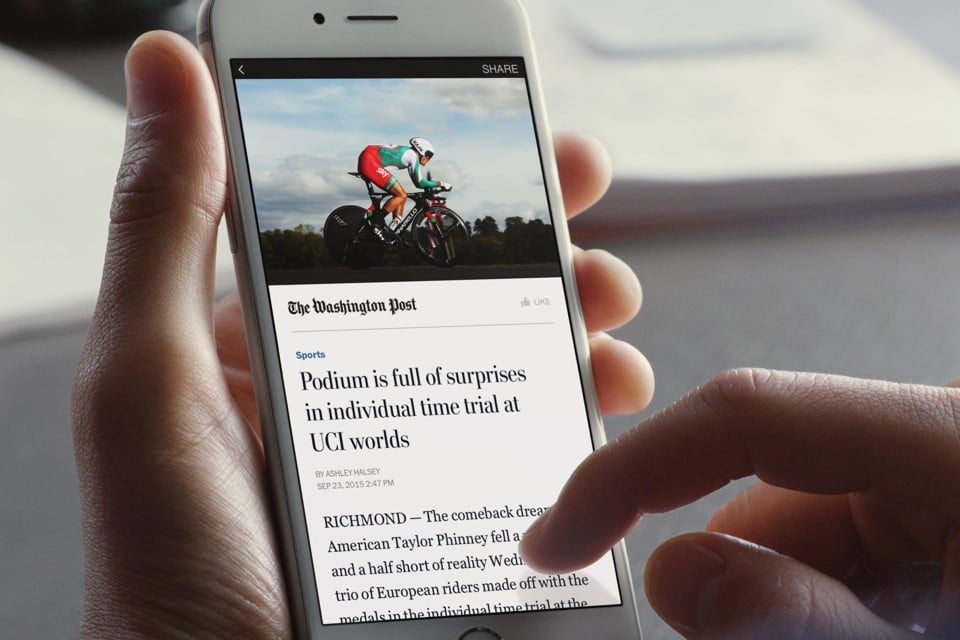
If you’re behind on the game, Instant Articles are a HTML5 document optimized for fast mobile performance, rich storytelling capabilities, branded design and customized visual display.
“Instant Articles are a huge deal because Facebook is building the infrastructure to allow publishers to live within its platform. This works great because it exposes publishers to a larger audience, but it’s essentially establishing Facebook as the digital newspaper for the world. They’ve given publishers incentives to move over to this platform, revenue share, branded content and options for increasing subscriptions,” said Brian Meert, CEO at Advertisemint.
Building an Instant Article does not automatically create a corresponding Facebook post. It is a separate tool meant to enhance your article once someone shares it on Facebook. It simply means that any time a reader on a mobile device is directed to the article’s URL on Facebook, the link will be displayed as an Instant Article.
Before you get started, check out some of the numbers that Facebook shared at the F8 conference today.
Instant Articles Stats:
- There are 1,000 publishers
- 10,000 Instant Articles are published daily
- They get 20% more clicks than mobile web articles
- Readers are 70% less likely to abandon
- Instant Articles experience 30% more shares than mobile web articles
How? Read on and find out why Instant Articles are the bomb-dot-com.
Advantages:
- Better Experience for Readers. Instant Articles displays stories as much as 10 times faster than conventional mobile browsers, while also providing the kind of fluid, high-quality experience and interactivity readers want.
- New Creative Tools. Instant Articles introduces a suite of creative tools that allow publishers to bring their stories to life in new ways, with high-resolution photos, auto-play videos, interactive maps and audio captions.
- Built for Publishers. Instant Articles keeps publishers in control. Publishers decide what to share on Facebook, with article templates that mirror the look and feel of their brands. Publishers can even automate their workflow by using an RSS feed or API to publish Instant Articles directly from their existing content management systems.
Analytic Capabilities:
Facebook designed Instant Articles to give publishers the resources they need to nurture successful publishing businesses. In the Instant Articles program, publishers can sell and serve their own advertisements in Instant Articles and keep 100% of the revenue, and they can monetize with ads from Facebook’s Audience Network.
To track audience and engagement, Instant Articles is compatible with industry-standard content analytics tools such as Google Analytics and comScore attribution. Publishers can also use their existing web-based analytics systems or third-party providers to track article traffic.
“However, if publishers jump on board with this, this has the ability to become a defining moment for the publishing industry. Just like how publishers moved from newspapers to online, this is now a huge transition for publishers from their own websites onto Facebook. For the sake of greater readership, publishers are about to sign the deal that essentially gives Facebook all the control over how their content is published,” said Meert.
Advertising:
Instant Articles is designed to give publishers control over the ads experience. Publishers can sell ads in their articles and keep the revenue or they can use Facebook’s Audience Network to serve ads and earn an industry standard revenue share. Publishers can also serve video ads (click to play or sound off), animated ads (provided animation says within the iframe) and banner ads that have been sold directly by their own sales team into their Instant Articles. Publishers keep 100% of the revenue generated by ads they sell themselves – woo!
Ads can be served into your Instant Articles through your existing ad server implementation, including through Google’s DFP solution. Since your ads are served into Instant Articles within an iframe and embedded web browser, you can employ your own existing techniques to measure and account for the viewability of these ads back to your advertisers. You can use Javascript to track and measure ad viewability for these ads in your Instant Articles. Also, you can still use your standard cookie or contextual data for targeting as you do for ads on your website.
Audience Network:
In addition to serving ads that have been sold directly by your team, you can also incorporate ads from Audience Network into your Instant Articles. Through high-value native formats and people-based targeting, Audience Network delivers relevant, engaging ads from over 3 million advertisers on Facebook.
Meert added, “This is also a big deal because it creates a fair playing field for blogs to compete with large publishers. The content that is the best (not the publisher that produced it) will now have the ability to reign supreme when viewed on Facebook. Instant Articles is going to be great for driving users to publishers content, but also bring them into a new era where the rules of the game are changed.”
If we missed anything (oops), you should find the rest of the details below.
